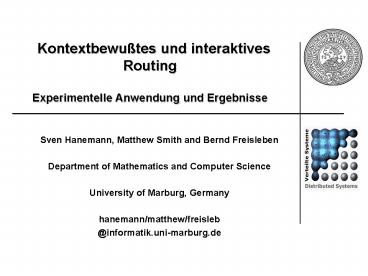Kontextbewutes und interaktives Routing Experimentelle Anwendung und Ergebnisse - PowerPoint PPT Presentation
1 / 20
Title:
Kontextbewutes und interaktives Routing Experimentelle Anwendung und Ergebnisse
Description:
informatik.uni-marburg.de. Contents: Published Results 2003. Recent Results ... Stage simulates a population of mobile robots moving within two dimensional environment ... – PowerPoint PPT presentation
Number of Views:159
Avg rating:3.0/5.0
Title: Kontextbewutes und interaktives Routing Experimentelle Anwendung und Ergebnisse
1
Kontextbewußtes und interaktives
RoutingExperimentelle Anwendung und Ergebnisse
- Sven Hanemann, Matthew Smith and Bernd Freisleben
- Department of Mathematics and Computer Science
- University of Marburg, Germany
- hanemann/matthew/freisleb
- _at_informatik.uni-marburg.de
2
Contents
- Published Results 2003
- Recent Results
- Cross-Layer Adaptivity (Reminder)
- Scenario
- Evaluation Environment
- Routing-Layer Aware Application
- Experimental Results
- Conclusions
3
Published Results 2003
- Proactive Distance-Vector Multipath Routing for
- Wireless Ad Hoc Networks
- (Proceedings of IASTED International
Conference - Communication Systems and Networks (CSN
2003), - Result Load distribution, Reduced Link
average link break - time
- Update Message Delay An Approach for Improving
- Distance Vector Routing in Wireless Ad Hoc
- Networks
- (Proceedings of IEEE Symposium on
Communications and Vehicular Technology
(SCVT 2003), - Result Routing message reduction up to 15
- Reducing Packet Transmission in Ad Hoc Routing
- Protocols by Adaptive Neighbor Discovery
- (Proceedings of the International Conference
on - Wireless Networks 2003 (ICWN03)
- Result Constant mean error rate by dynamic
adaptation
4
Recent Results Cross-Layer Adaptivity
Direction Routing-layer aware application
-gt Routing-triggered application
- Mobility
- Mobility does not solely happen to a network!
- Network information influences mobility decisions!
- Experiment
- Java application
- Real Linux systems
- Topology control for
- network preservation
5
Scenario
- Mineclearing
- 4 Searcher Robots
- 1 Clearing Robot
- Sensor Laser Scanner
- 2 Minefields
- Range limited comms.
Shadow Deminer The Shadow Robot Company
6
Player / Stage
- Player
- Player provides a network interface for a variety
of robot and sensor hardware - Multi language support
- Stage
- Stage simulates a population of mobile robots
moving within two dimensional environment - Stage is designed to simulate a large number of
robots at low fidelity.
Stage Hospital
7
User Mode Linux
- Real Linux
- Real Network
- Real Robot
- Control Interface
- UML Testbed for the ad hoc network
8
Architecture Overview
9
Routing-Layer Aware Application
Goal Keep the network intact while at the same
time allowing maximum freedom to execute primary
task! Solution Cross-layer active and passive
network preservation algorithms.
10
Routing-Layer Aware Application
Passive Network Preservation
- Network Preservation Criteria
- Distance to neighbours
- Direction of travel of neighbours
- Own position
- Destination
- Passive Network Preservation
- does not interfere with active
- tasks!
11
Routing-Layer Aware Application
Passive Network Preservation does not guarantee
network integrity!
Active Preservation
- Network Preservation Criteria
- Last know position of
neighbours - Last known direction of travel of neighbours
- Last known destination of neighbours
- Passive Preservation runs as non-interfering
background task.
- Active Network Preservation
- overrides active tasks!
12
Active Network Preservation
- Node 1 leaves network
- Cache last known position of neighbours
- Cache last known direction of travel of
neighbours - Cache last known destination of neighbours
- Active Network Preservation
- overrides active tasks! Outset
Active Preservation is inactive!
13
Video
- Demonstration of Active/Passive Network
Preservation algorithm as an example for
cross-layer applications
14
Conclusions
- Active and Passive Network Preservation
Algorithms based on - cross-layer adaptation offer
- Ability to self heal broken network links
- Improved coverage of network space
- Connection reliability in sparse networks
15
Future Work
16
Questions?
- Thank you for your attention!
- Any Questions?
17
Update Message Delay An Approach for Improving
Distance Vector Routing in Wireless Ad Hoc
Networks
- Aim
- Improving bandwidth and energy consumption by
reducing - unnecessary updates
- Benefits
- Routing message reduction up to 15
Number of required messages (180 meters
transmission range)
Reachable destinations (180 meters
transmission range)
18
Proactive Distance-Vector Multipath Routing for
Wireless Ad Hoc Networks
- Aim
- Equip proactive routing with the capability of
using multiple paths to each target by using
already available topology information - Benefits
- Load distribution, bottleneck avoidance, fairness
and - less communication breaks
Ohne Mehrwege
Mit Mehrwege
TERA mit Mehrwege TERA ohne Mehrwege
Last in
Last in
Communication breakdown length sec
Gitterhöhe
Gitterhöhe
Gitterbreite
Gitterbreite
Movement speed in m/s
Without multipath
With multipath
Improved average link breakage duration
19
Reducing Packet Transmission in Ad Hoc Routing
Protocols by Adaptive Neighbor Discovery (1)
- Aim
- Minimize bandwidth consumption according to user
requirements by adjusting neighbor detection
accuracy - Benefits
- Constant average error
- rate by dynamic adaptation
- Adaptive neighbor detection
- algoritm
- Maximal service availability with
- minimal bandwidth consumption
Scheme of a single node
20
Reducing Packet Transmission in Ad Hoc Routing
Protocols by Adaptive Neighbor Discovery (2)
- Constant average error rate by dynamic
adaptation
Bandwidth consumption with constant average error
rate
Evaluation of algorithm behavior































